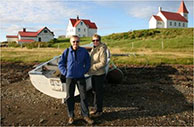Mauritius – what a surprise
Monday, 3 November 2025 ▲ A serious Mauritian sunset from the west coast resort beach strip of Flic-en-Flac. What a great name – ‘Flic-en-Flac’ most likely means ‘Free and Flat Land’, a name derived from an Old Dutch phrase ‘Fried Landt Flaak’ that reflects the area’s historically open and level terrain.
▲ A serious Mauritian sunset from the west coast resort beach strip of Flic-en-Flac. What a great name – ‘Flic-en-Flac’ most likely means ‘Free and Flat Land’, a name derived from an Old Dutch phrase ‘Fried Landt Flaak’ that reflects the area’s historically open and level terrain.
My 2025 travels certainly included some surprises (generally pleasant ones!) including Jamaica and Algeria, but Mauritius probably tops the surprising list. Where is it? In the Indian Ocean, closer to Africa than to Australia, not far east of much larger Madagascar. Population density? The highest in Africa, 1.25 million people on an island of just over 2000 square km. Income per capita? Vying with Seychelles as the wealthiest country in Africa, if you count it as an African nation.
 And where are Mauritians from? Well not from Mauritius, it’s an immigrant nation, there had been Arab and Malay visitors before the Europeans – Portuguese, then Dutch, then French, then British – turned up, but there were no native Mauritians. Mauritius really was terra nullius.
And where are Mauritians from? Well not from Mauritius, it’s an immigrant nation, there had been Arab and Malay visitors before the Europeans – Portuguese, then Dutch, then French, then British – turned up, but there were no native Mauritians. Mauritius really was terra nullius.
And Mauritius today? It’s overwhelmingly Indian, the population is 68% Indian with Hinduism as the largest religion.
◄ Shiva statue at Grand Bassin, the most important Hindu religious site in Mauritius
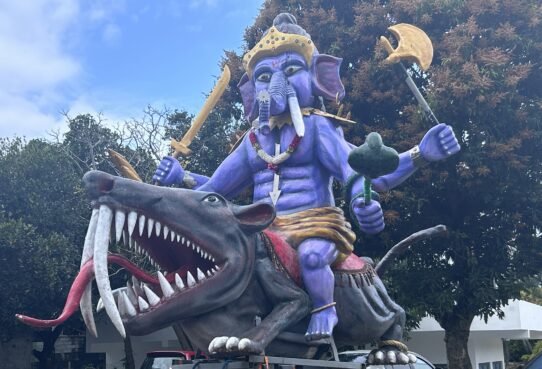 ▲ Ganesh statue created for the Ganesh Pooja festival. The much-loved elephant-headed god is a benevolent god of wisdom and prosperity, a stone Ganesh statue from Bali sits happily on my apartment bedroom balcony in Melbourne. Well this temporary Mauritian Ganesh is definitely not a standard Ganesh, he’s ferocious looking, with four arms wielding weapons. Every Hindu god has an animal ‘vehicle’ and for Ganesh it’s a mouse and his Mauritian ‘mouse’ is very different from the Ganesh standard rodent, it’s a savage looking mouse with saber teeth and a long red tongue.
▲ Ganesh statue created for the Ganesh Pooja festival. The much-loved elephant-headed god is a benevolent god of wisdom and prosperity, a stone Ganesh statue from Bali sits happily on my apartment bedroom balcony in Melbourne. Well this temporary Mauritian Ganesh is definitely not a standard Ganesh, he’s ferocious looking, with four arms wielding weapons. Every Hindu god has an animal ‘vehicle’ and for Ganesh it’s a mouse and his Mauritian ‘mouse’ is very different from the Ganesh standard rodent, it’s a savage looking mouse with saber teeth and a long red tongue.
 ▲ Notre-Dame Auxiliatrice Church, Cap Malheureux – a postcard perfect Catholic church perched at the northern tip of the island. Christianity is the second most followed religion, after Hinduism. The north-west strip of Mauritius through Grand Baie and turning the corner at Cap Malheureux, features assorted popular beaches.
▲ Notre-Dame Auxiliatrice Church, Cap Malheureux – a postcard perfect Catholic church perched at the northern tip of the island. Christianity is the second most followed religion, after Hinduism. The north-west strip of Mauritius through Grand Baie and turning the corner at Cap Malheureux, features assorted popular beaches.
 ▲ Chateau Labourdonnais with its museum collection, gardens and rum tasting, since they produce rum here, is a reminder of La Bourdonnais’s outsized influence on the island. His name pops up all over the place in Mauritius and it’s also a reminder of the island’s French history. Making sugar the big crop was probably his prime claim to fame and although sugar is still important, you certainly pass by many hectares of sugar cane plantation, today tourism is a much larger part of the economy. Yes there is a Labourdonnais Waterfront Hotel in Port Louis.
▲ Chateau Labourdonnais with its museum collection, gardens and rum tasting, since they produce rum here, is a reminder of La Bourdonnais’s outsized influence on the island. His name pops up all over the place in Mauritius and it’s also a reminder of the island’s French history. Making sugar the big crop was probably his prime claim to fame and although sugar is still important, you certainly pass by many hectares of sugar cane plantation, today tourism is a much larger part of the economy. Yes there is a Labourdonnais Waterfront Hotel in Port Louis.
On my way to the chateau I’d also visited the Pamplemousse Botanic Gardens, originally created by that hard-working Frenchman. In the gardens I’d encountered a statue of Paul & Virginie, from the Mauritian Romeo & Juliet-style tragic novel by Jacques-Henri Bernardin de Saint-Pierre. In the chateau there is a room dedicated to the romantic young couple with a big assortment of Paul & Virginie editions, illustrated versions, cartoons, movies and so on. The novel’s finale emphasises that she was so carefully pure that she chose to drown, in a shipwreck, dragged down by her weighty waterlogged attire rather than shed it and reveal her unclothed flesh to the male gaze. So why is there a showcase devoted to illustrated editions depicting Ms Virginie cavorting round naked?
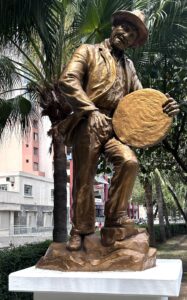 ◄ The statue of Jean Alphonse Ravaton (‘Ti Frère’) in the Jardins de la Compagnie, Port Louis – there is no shortage of statues in Mauritius, particularly of politicians. This one of ‘Ti Frere,’ little brother in Creole, is probably far more popular than any of the political versions. He is regarded as the father of the much-loved Sega music of Mauritius.
◄ The statue of Jean Alphonse Ravaton (‘Ti Frère’) in the Jardins de la Compagnie, Port Louis – there is no shortage of statues in Mauritius, particularly of politicians. This one of ‘Ti Frere,’ little brother in Creole, is probably far more popular than any of the political versions. He is regarded as the father of the much-loved Sega music of Mauritius.
Photographic Museum in Port Louis – the capital also features a fine photographic museum tracing the history of film and photography on the island with a great collection of cameras (look, there’s my Box Brownie) and some wonderful old cinema movie projectors. ▼
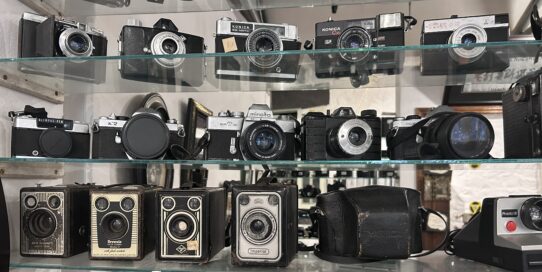
 ◄ Voiliers de l’Océan ship models, Curepipe – the ‘sailing ships of the ocean’ turns out beautifully crafted sailing ships. The place is half museum/half shop and features a wide variety of models of modern ships from ocean liners to naval vessels as well as the historic vessels.
◄ Voiliers de l’Océan ship models, Curepipe – the ‘sailing ships of the ocean’ turns out beautifully crafted sailing ships. The place is half museum/half shop and features a wide variety of models of modern ships from ocean liners to naval vessels as well as the historic vessels.
In the centre of the island Curepipe is the second largest Mauritian city and its altitude keeps it cool. It features the perfectly circular Trou au Cerfs – hole of deer although there are no deer to be found – volcano crater. The many French names in Mauritius are a reminder that the island has three ‘official’ languages, English, French and Creole.
Quite apart from the large numbers of the Indian population speaking Tamil and other languages from the sub-continent. Only 2% of the population is Franco-Mauritian, a term which also seems to include the Anglo-Mauritian minority, who happily swap between French and English. Despite their small numbers the Franco-Mauritians have a quite disproportionate hold on the economy.
 ▲ Ile au Phare (Lighthouse Island) – the lighthouse is not in use, but it’s perched right on the reef that fringes the east coast of Mauritius from Trou d’Eau Douce (Fresh Water Hole in French) south past Mahebourg. I stayed in both of them.
▲ Ile au Phare (Lighthouse Island) – the lighthouse is not in use, but it’s perched right on the reef that fringes the east coast of Mauritius from Trou d’Eau Douce (Fresh Water Hole in French) south past Mahebourg. I stayed in both of them.
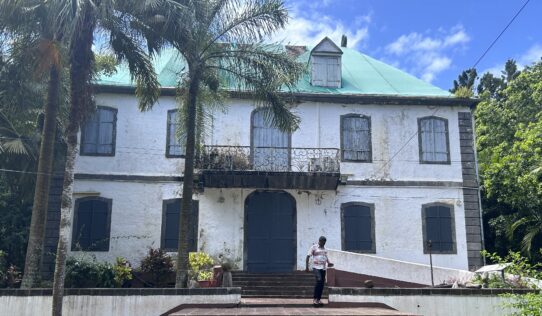 ▲ Mahebourg Museum – Mahebourg was the site for the Grand Port Naval Battle in 1810, France won the battle, but the British won the war and Mauritius remained a British colony until independence in 1968. It’s still part of the Commonwealth today. The wonderfully old-fashioned museum tells the story of Mahebourg’s moment in Mauritian history and a lot more of the Mauritian story.
▲ Mahebourg Museum – Mahebourg was the site for the Grand Port Naval Battle in 1810, France won the battle, but the British won the war and Mauritius remained a British colony until independence in 1968. It’s still part of the Commonwealth today. The wonderfully old-fashioned museum tells the story of Mahebourg’s moment in Mauritian history and a lot more of the Mauritian story.
 ▲ The Intercontinental Slavery Museum in the capital, Port Louis – Mauritius was certainly in the African slave trade region, but slavery did not play a large part in the Mauritius story.
▲ The Intercontinental Slavery Museum in the capital, Port Louis – Mauritius was certainly in the African slave trade region, but slavery did not play a large part in the Mauritius story.
So if the French and British fought over Mauritius, how did the population end up Indian? Because the colonial administrators decided slavery was not going to work, but labour was needed for the sugar plantations which for many years were the key part of the Mauritius economy. The answer was indentured labour and right next to the slavery museum is the Aapravasi Ghat Interpretation Centre, which tells the story of the Mauritius indenture system because this is where the Indian population of Mauritius turned up. The indenture system signed up Indians who were shipped to Mauritius and spent their first two days on the island being processed here. It may have been hard work in often miserable conditions with the legal balance firmly tipped against them, but although they were free to return to India once their indentured period was completed most of them stayed, hence the large Indian population today.
 ▲ The animated dodo at the Natural History Museum in the capital, Port Louis. Poor Mauritius, the ‘dumpy, dowdy mythical bird’ is as much a symbol of Mauritius as the panda is for China or the kiwi for New Zealand and yet we wiped dodos out pretty much as soon as we discovered them. Of course we would probably have done a good job of killing it ourselves, but we also introduced assorted pests – rats in particular – which did the hard exterminating work. A flightless, metre-high, 20kg, dumb-ugly bird simply wasn’t going to have a chance, even if some sailors quickly decided they tasted awful. The last ones were gone in the late 1600s.
▲ The animated dodo at the Natural History Museum in the capital, Port Louis. Poor Mauritius, the ‘dumpy, dowdy mythical bird’ is as much a symbol of Mauritius as the panda is for China or the kiwi for New Zealand and yet we wiped dodos out pretty much as soon as we discovered them. Of course we would probably have done a good job of killing it ourselves, but we also introduced assorted pests – rats in particular – which did the hard exterminating work. A flightless, metre-high, 20kg, dumb-ugly bird simply wasn’t going to have a chance, even if some sailors quickly decided they tasted awful. The last ones were gone in the late 1600s.
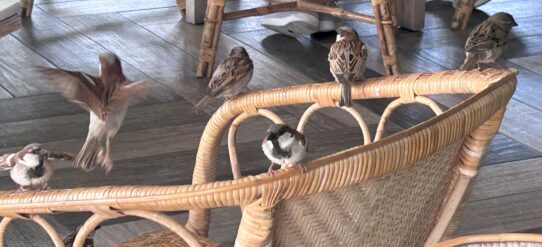 ▲ In Mauritius today I enjoyed the incredibly cheeky sparrows. At every resort they gang up to enjoy breakfast and any other food possibilities available. This breakfast crowd is at Sugar Beach Resort at Flic-en-Flac
▲ In Mauritius today I enjoyed the incredibly cheeky sparrows. At every resort they gang up to enjoy breakfast and any other food possibilities available. This breakfast crowd is at Sugar Beach Resort at Flic-en-Flac
